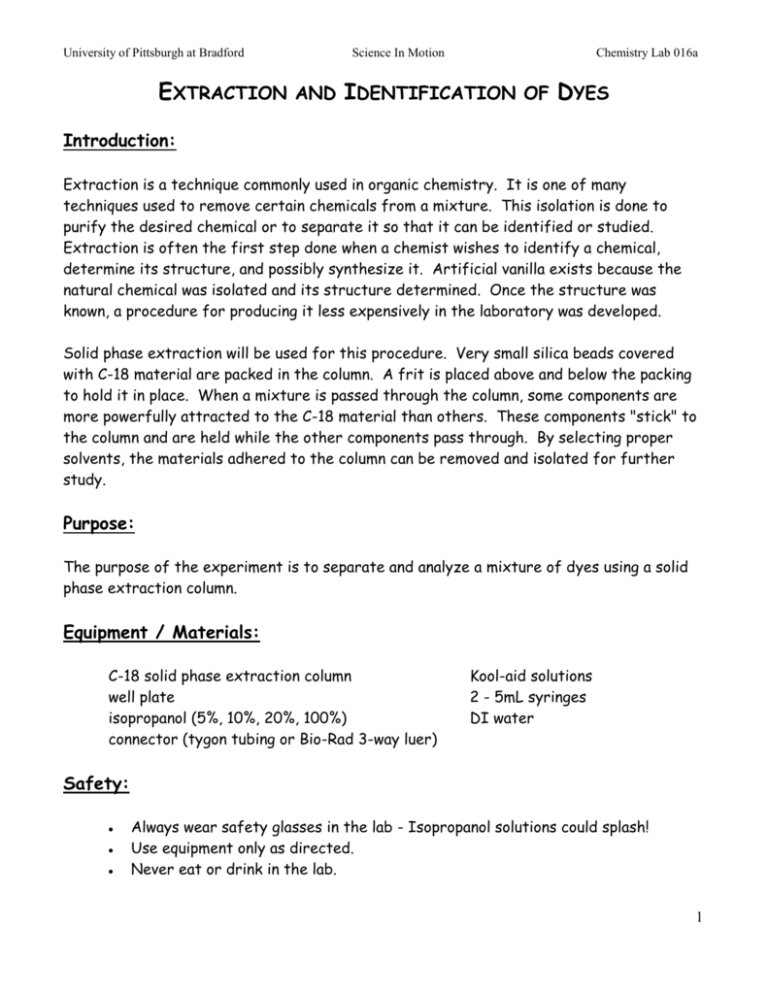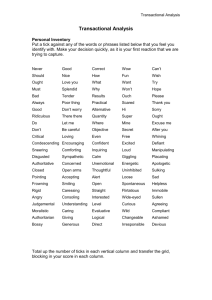EXTRACTION AND IDENTIFICATION OF DYES
advertisement

University of Pittsburgh at Bradford Science In Motion Chemistry Lab 016a EXTRACTION AND IDENTIFICATION OF DYES Introduction: Extraction is a technique commonly used in organic chemistry. It is one of many techniques used to remove certain chemicals from a mixture. This isolation is done to purify the desired chemical or to separate it so that it can be identified or studied. Extraction is often the first step done when a chemist wishes to identify a chemical, determine its structure, and possibly synthesize it. Artificial vanilla exists because the natural chemical was isolated and its structure determined. Once the structure was known, a procedure for producing it less expensively in the laboratory was developed. Solid phase extraction will be used for this procedure. Very small silica beads covered with C-18 material are packed in the column. A frit is placed above and below the packing to hold it in place. When a mixture is passed through the column, some components are more powerfully attracted to the C-18 material than others. These components "stick" to the column and are held while the other components pass through. By selecting proper solvents, the materials adhered to the column can be removed and isolated for further study. Purpose: The purpose of the experiment is to separate and analyze a mixture of dyes using a solid phase extraction column. Equipment / Materials: C-18 solid phase extraction column well plate isopropanol (5%, 10%, 20%, 100%) connector (tygon tubing or Bio-Rad 3-way luer) Kool-aid solutions 2 - 5mL syringes DI water Safety: Always wear safety glasses in the lab - Isopropanol solutions could splash! Use equipment only as directed. Never eat or drink in the lab. 1 Procedure: 1. The column must first be conditioned to remove any contaminants and to "wet" the column. Each solution is placed on top of the column and drawn through until a small amount of the liquid remains on top of the frit. Never allow the column to go dry, and never push on the withdrawing syringe - this action will destroy the column. 2. Turn the lever toward the open end of the apparatus. Place ~ 5 mL of 100% isopropanol in the column and pull into the syringe. 3. Turn the lever toward the column and push the solution into a well or sink. 4. Repeat steps 2 & 3 with ~ 5 mL of DI water 5. Turn the lever toward the open end of the apparatus. Place ~ 5 mL of the Kool-Aid in the column and slowly begin to draw the solution into the syringe. Observe what is happening in the column. 6. When the effluent is completely drawn through to the top of the frit, aim the lever toward the column. Place some of the effluent in the well plate; discard the remainder. 7. Continuing with this extraction, apply the following solutions (in this order) and collect some of the effluent from each step in the well plate. Note: Be certain that the lever is in the appopriate position so that the column is not destroyed! Solution 5 mL water 5 mL 5% isopropyl alcohol 5 mL 10% isopropyl alcohol 5 mL 20% isopropyl alcohol 5 mL 100% isopropyl alcohol 8. Record the colors of the effluent and the column on the data table for each step. 9. Clean-up and repeat the procedure for at least one other Kool-Aid flavor with similar dyes to the first one. 2 EXTRACTION AND IDENTIFICATION OF DYES STUDENT EVALUATION Data Table: Kool-Aid: ____________________ well # added: 1 2 3 4 5 6 Kool-Aid water 5% 10% 20% 100% Color of Effluent Color of Column Kool-Aid: ____________________ well # added: 1 2 3 4 5 6 Kool-Aid water 5% 10% 20% 100% Color of Effluent Color of Column Questions: 1. Did your Kool-aid samples contain any of the same dyes? Explain your answer. 2. In your first sample, which dye had the highest affinity (attraction) to the column? Explain. 3. If two different colors both came through using 10% isopropyl alcohol, how would you change the extraction to make these separate? 3








